
The Bottom Line
Introduction and Package
Introduction of the Sapphire R9 290X 8GB Vapor-X OC

AMD is struggling with video card sales at the moment, and to be honest, it doesn't take a discussion with AMD partners to figure that out. With a huge shift in management, and a bunch of jumbling occurring internally, the company seems to be a bit all over the place. Although, as much as I hate to say it, this doesn't seem all that far away from where the company has been for years now.
If all that wasn't enough for AMD to contend with, the fact that the new Maxwell based NVIDIA cards are just so awesome makes it even more difficult for the company when it comes to meeting the demands of those who want a high-end gaming system. Personally, I have been a long-time AMD loyalist when it comes to my personal system, and I was going to use the R9 295 X2 8GB. However, once the Maxwell cards launched, I jumped straight onto the GTX 980 4GB bandwagon.
So, what is AMD doing to try and grab the attention away from the new GTX 900 series? Well, price drops are the biggest thing, and the R9 290X 4GB is now priced at a similar price point to the GTX 970 4GB. With similar performance, the decision of which one to buy is a little harder than it was a month ago, but the one thing we constantly come back to is the fact that people aren't so interested in buying a card that is a year old now.
Along with the price drops, AMD has also released an 8GB version of the popular R9 290X through its AIB partners. While I think this is cool, if past experiences are anything to go by, doubling the amount of memory on this card won't do a whole lot for performance, and instead just cause the price to jump up. This does feel like a bit of a Hail Mary move by AMD, but it will be interesting to see what double the amount of memory actually does to performance. This will be especially true when we start to look at our higher resolution testing, and the performance of the cards in some of our newer benchmarks that have been added since our X99 upgrade.
Package - What comes inside the box
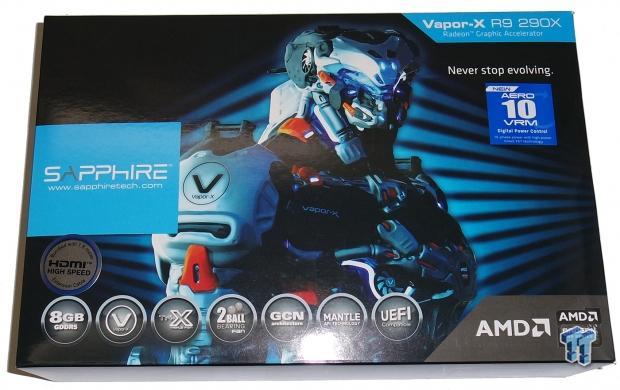
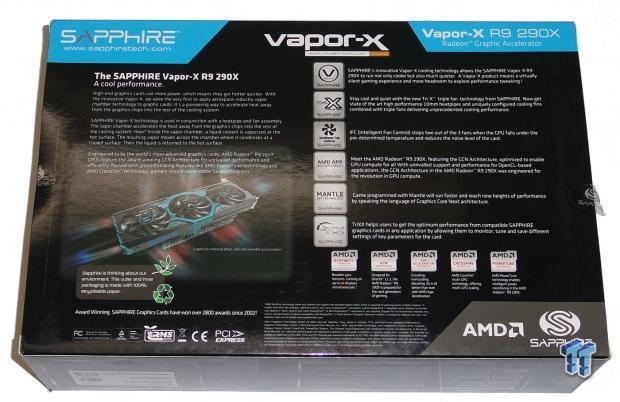
Looking at the front of the box, you can see we've got the same blue color theme that we've seen on other Vapor-X based cards. You can see the model listed at the top of the box, and below that, you can see mention of the new AERO10 VRM digital power control, which brings with it a ten phase power design. Across the bottom, you can see some of the other major features, which include the massive 8GB of GDDR5, Tri-X triple fan, Vapor-X cooling technology, and two ball bearing fan.
On the opposing side of the box, you can see a bit of a blurb, along with a picture of the card. On the right hand side of the box, we can see some of the main features that we just mentioned, and explanations of some of the more major features. As you can see, most of the push is on the cooling, which is provided by the Vapor-X cooler, Tri-X triple fan setup, and the new IFC (Intelligent Fan Control) technology that stops two of the fans from spinning when they are unnecessary, in order to reduce noise.


Inside of the box, we've got a pretty standard Sapphire bundle, including the normal array of paperwork, and a driver CD. Cable wise, we've got two dual Molex to eight-pin PCIe power connectors, along with the standard HDMI cable that we see in higher-end Sapphire offerings. Along with all of this, you can see that we've also got a mouse pad, which (like the HDMI cable) is something that we've seen Sapphire include with some of its higher-end cards.
PRICING: You can find the Sapphire R9 290X 8GB Vapor-X OC for sale below. The prices listed are valid at the time of writing, but can change at any time. Click the link to see the very latest pricing for the best deal.
United States: The Sapphire R9 290X 8GB Vapor-X OC retails for $499.99 at Amazon.
Video Card Details and Specifications
Close up with the Sapphire R9 290X 8GB Vapor-X OC
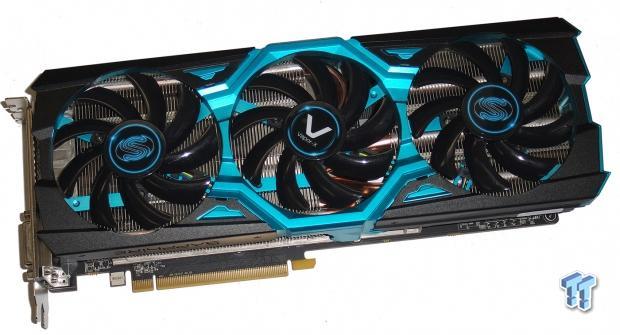
Upon looking at the card, you'll immediately notice that there is nothing that we haven't seen before. This is due to the fact that we've already looked at the Vapor-X versions of the R9 290 and R9 290X from Sapphire, both of which feature the massive Tri-X cooler. You can see a tiny bit of the black PCB, but ultimately, it's all heat sink behind those three fans with a number of copper heat pipes coming out from the GPU area. The Vapor-X Tri-X cooler has already proved itself a number of times, and we're looking for it to offer some impressive performance numbers again today with this 8GB version of the R9 290X.


Looking around the card, you can see that power comes in the form of two, eight-pin PCIe power connectors, which is an upgrade from the standard single six-pin and single eight-pin PCIe power connector setup seen on reference design cards. Staying at the top of the card, but moving closer to the front, you can see being a R9 290 based card means that we don't have any CrossFire connectors, as they are unnecessary. However, we do have a BIOS switch here that lets us swap between two installed BIOS.

Finishing up our look at the card, you can see we've got two Dual-Link DVI connectors, along with a HDMI and DisplayPort connector. This is, of course, the standard R9 290X setup, and we liked it at launch. Although, we're seeing what the future of connectivity looks like with NVIDIA now offering three, full-size DisplayPort connectors, alongside a Dual-Link DVI and HDMI port.
Specifications
Out of the box, your reference R9 290X 4GB will come with a core clock of 1000MHz. The 4GB of GDDR5 will carry a nice, round clock speed of 5000MHz QDR. Of course, being a Vapor-X version of the card means that it comes out of the box overclocked.
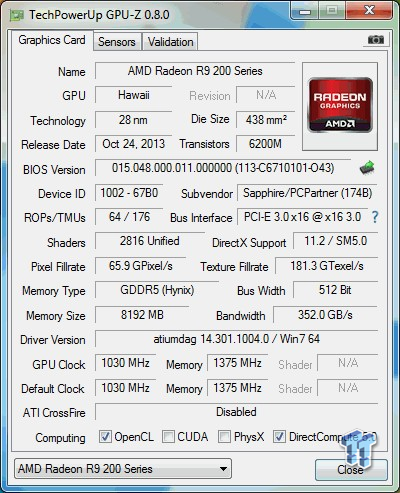
Looking above, you can see that Sapphire has chosen to bump the core clock ever slightly to 1030MHz. While most companies choose to ignore the memory clock, you can see that Sapphire has instead chosen to increase it to 5500MHz DDR.
Test System Setup & FPS Numbers Explained
Test System Setup

We would like to thank the following companies for supplying and supporting us with our test system hardware and equipment: Intel, ASUS, and Corsair.
As we mentioned before, we recently upgraded our testbed to move over to X99, and we're slowly, but surely, increasing the amount of video cards that are in our graphs. In our third review on the new testbed, we've got four video cards in our graphs.
On the AMD side, we've got our Sapphire R9 290X 8GB Vapor-X OC, which sits alongside the HIS R9 290X 4GB that is running at the stock reference speeds. As for the NVIDIA side, we've got the two recently reviewed ASUS STRIX cards, which include the GTX 970 4GB, and the top-end GTX 980 4GB.
The FPS Numbers Explained
When we benchmark our video cards and look at the graphs, we aim to get to a certain level of FPS which we consider playable. While many may argue that the human eye can't see over 24 FPS or 30 FPS, any true gamer will tell you that as we climb higher in Frames per Second (FPS), the overall gameplay feels smoother. There are three numbers we're looking out for when it comes to our benchmarks:
30 FPS - It's the minimum number we aim for when it comes to games. If you're not dropping below 30 FPS during games, you're going to have a nice and smooth gaming experience. The ideal situation is that even in a heavy fire fight, the minimum stays above 30 FPS, making sure that you can continue to aim easily, or turn the corner with no dramas.
60 FPS - It's the average we look for when we don't have a minimum coming at us. If we're getting an average of 60 FPS, we should have a minimum of 30 FPS or better, and as mentioned above, it means we've got some smooth game play happening.
120 FPS - This is the newest number that we've been hunting down over recent months. If you're the owner of a 120 Hz monitor, to get the most out of it, you want to get around the 120 FPS mark. Moving from 60 FPS / 60 Hz to 120 FPS / 120 Hz brings with it a certain fluidity that can't really be explained, but instead has to be experienced. Of course, if you're buying a 120 Hz monitor to take advantage of 3D, an average of 120 FPS in our benchmark means that in 3D you will have an average of 60 FPS, which again means you should expect some smooth gameplay.
Why are some graphs incomplete?
Adding new game benchmarks is a long, tedious, and time consuming task, as every video card has to be re-tested in those new benchmarks. For that reason, we have always just reevaluated our benchmark line up every six months. To stay up-to-date and current with the latest benchmarks and games available, we've changed our approach to adding new benchmarks.
Our benchmark line up will progress and be updated as newer, more intensive games with benchmarks comes to light. While this will mean that initially you may only see a single video card in those particular graphs, as the weeks go on and we test more and more video cards, the results will quickly grow. This will help keep our benchmark line up as up-to-date as possible as we introduce and remove games on a constant basis.
Benchmarks - 3DMark
3DMark Fire Strike
Version and / or Patch Used: 1
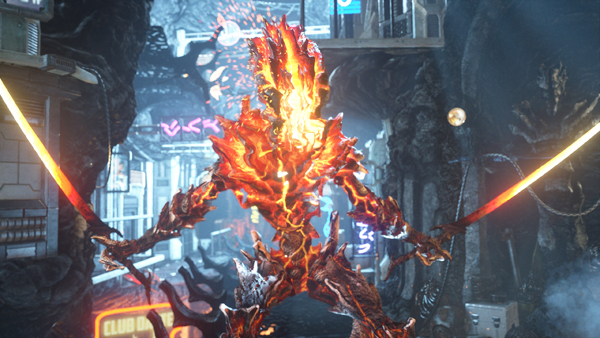

Starting off with 3DMark Fire Strike, you can see the R9 290X 8GB offers a slight performance boost over our reference card. This would be more attributable to the extra MHz on offer than the extra memory. Compared to the NVIDIA options, you can see we're sitting between both setups, and leaning closer to that lower-end GTX 970 4GB.
3DMark Sky Diver
Version and / or Patch Used: 1.1
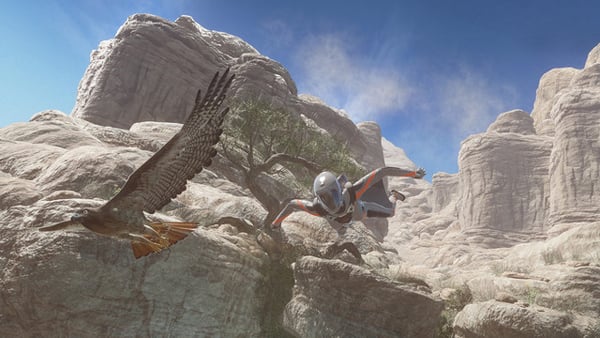

Getting into Sky Diver, you can see the performances of all four cards are quite similar, as this particular benchmark does focus more on mid-range models, and that means higher-end cards tend to sit quite close together.
Overall, though, the results are similar to what we saw above; there is a slight performance boost over the reference clocked card, and performance that sits between the two NVIDIA options - again leaning more towards the GTX 970 4GB.
Benchmarks - Catzilla & Unigine Heaven
Catzilla
Version and / or Patch Used: 1.3


When it comes to Catzilla, you can see that the NVIDIA offerings have a significant jump on the AMD offerings. While the 8GB version of the R9 290X from Sapphire does give us a bit of a performance increase, you can see we're still a decent chunk away from the performance numbers that we're seeing out of our NVIDIA setups.
Unigine Heaven Benchmark
Version and / or Patch Used: 3
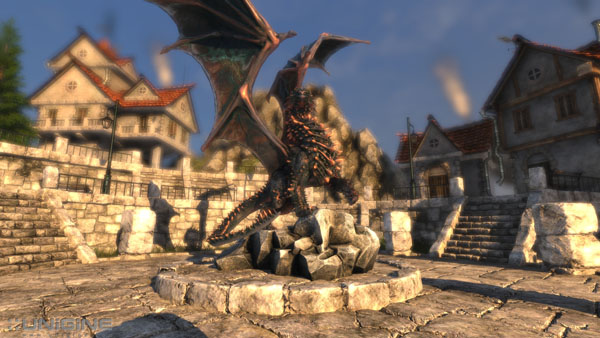

When it comes to Heaven performance, you can see that we've got an ever so slight bump in performance, which is most likely from the MHz increase. Compared to the NVIDIA offerings, you can see numbers sit in line with the GTX 970 4GB here. The GTX 970 4GB, on the other hand, really has no problem outperforming our AMD offerings.
Benchmarks - Unigine Valley & Just Cause 2
Unigine Valley Benchmark
Version and / or Patch Used: 3


Unlike Heaven, you can see that Unigine Valley Benchmarks seem to benefit a bit more with the extra MHz and memory, with a strong increase shown that puts our 8GB version of the R9 290X ahead of the GTX 970 4GB. Although, you can see that the GTX 980 4GB continues to dominate the others setups here.
Just Cause 2
Version and / or Patch Used: Latest Steam Update


Just Cause 2 performance is pretty much hitting a mid-80s FPS wall at all resolutions, which sees all of our cards sit fairly close together here. However, at the highest resolution, you see our AMD offerings have a decent jump over the GTX 970 4GB in this case.
Benchmarks - Metro: Last Light & Sleeping Dogs
Metro: Last Light
Version and / or Patch Used: Latest Steam Update


Metro: Last Light was one benchmark that I thought would really benefit from the extra memory; I expected the 8GB version of the R9 290X to perform here in the same way we saw the NVIDIA GeForce TITAN perform exceptionally well under it. However, you can see the overall FPS doesn't change that much, with the extra performance more than likely coming from the increase in clock speeds, rather than the extra memory.
Sleeping Dogs
Version and / or Patch Used: Latest Steam Update


Sleeping Dogs performance is strong across the board, but overall, you only see a slight performance boost over the reference clocked 4GB version of the R9 290X 4GB. Overall, those numbers are a decent chunk behind the NVIDIA offerings at all resolutions.
Benchmarks - Hitman: Absolution & Tomb Raider
Hitman: Absolution
Version and / or Patch Used: Latest Steam Update
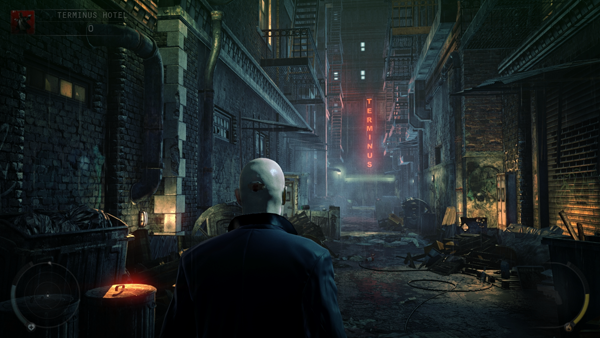

Thanks to a FPS wall that is hit quite early on in the AMD offerings, we see both R9 290X cards perform almost identically to each other. While the NVIDIA cards also hit a FPS wall, it comes on at a much later point, and because of that you can see both the GTX 970 and GTX 980 manage to get a nice jump on the AMD offerings.
Tomb Raider
Version and / or Patch Used: Latest Steam Update
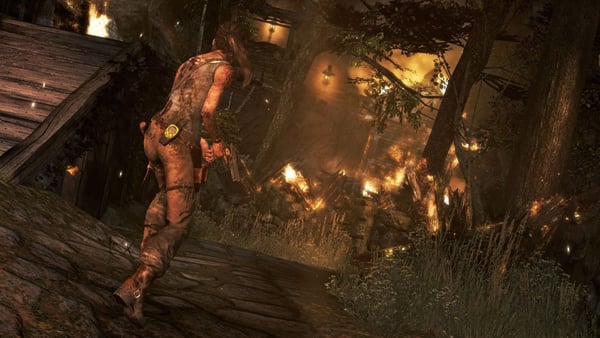

Tomb Raider is one of the more recent benchmarks that favors the AMD offerings. Looking above, you can see that while we manage to perform well against the GTX 980 4GB, doubling the video memory has really done nothing to overall performance.
There is only a slight performance boost shown in comparison to the reference clocked card. As we've already mentioned a number of times, the extra performance is more than likely coming from the MHz increase, rather than the extra memory capacity that is available.
Benchmarks - BioShock Infinite & Battlefield 4
BioShock Infinite
Version and / or Patch Used: Latest Steam Update
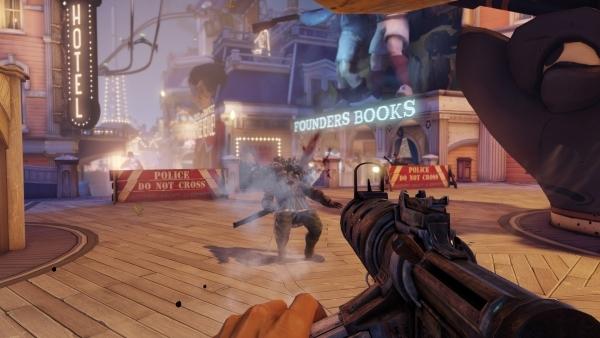

BioShock Infinite continues the trend of very little change in overall FPS when comparing the 8GB R9 290X from Sapphire to the 4GB reference clocked version from HIS.
What's worse, though, is the fact that at the highest resolution, you can see the AMD offerings fall short of that 60 FPS average, while the GTX 970 4GB manages to hit it with no problem, giving us a 66 FPS average.
Battlefield 4
Version and / or Patch Used: Latest Origin Update


Battlefield 4 numbers are solid across the board, but when we put both setups on an even playing field and don't use Mantle, you can see that the AMD offerings manage to fall slightly behind again. Of course, the big advantage for AMD and Battlefield 4 is that you do have the option to enable Mantle, which will help give a solid boost in overall FPS.
Benchmarks - GRID Autosport
GRID Autosport
Version and / or Patch Used: Latest Steam Update
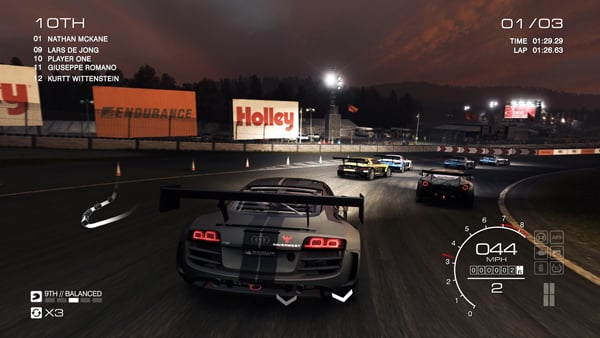

Looking at the GRID Autosport numbers, you can see the FPS wall is again a slight issue at the lower resolutions. Due to the fact it comes on at an earlier point than in the NVIDIA cards, we see the AMD offering lag behind a little at the lower resolution.
As we climb the resolution table, it becomes a bit more even, and in the end, we see our 8GB R9 290X from Sapphire perform fairly in line with the GTX 980 4GB at the highest resolution. More interestingly, though, is the fact that compared to the reference clocked 4GB cards, we see a significant boost in performance for the first time.
F1 2014
Version and / or Patch Used: Latest Steam Update


Thanks to a FPS wall at the mid-120 FPS mark, you can see that all four cards here perform pretty much on top of each other, with just a few FPS separating all of them.
Benchmarks - Middle-earth: Shadow of Mordor
Version and / or Patch Used: Latest Steam Update


Middle-earth: Shadow of Mordor tends to favor the AMD offerings here, and you can see one of our high-end cards is able to break the 60 FPS mark for the first time. The Sapphire R9 290X 8GB manages to sneak past that 60 number with a solid 61 FPS average.
Benchmarks - High Quality AA and AF
High Quality AA and AF Testing
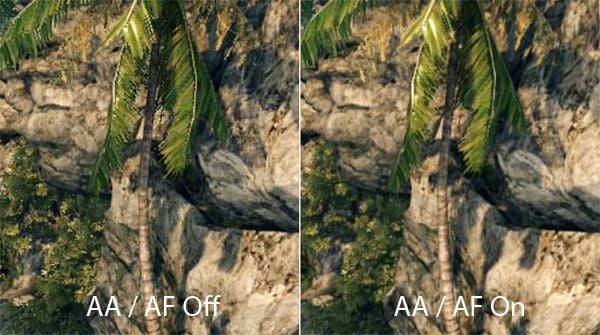
While we test all our games with maximum in-game settings, turning on Anti-Aliasing (AA) and Antistrophic Filtering (AF) helps take the intensity of our testing to another level.
Here we see video cards go from playable FPS to unplayable FPS, and the real power houses continue to help break that 60 FPS mark we always aim for to provide a smooth gaming experience.

Metro: Last Light performance is quite similar between most of the setups here, and there is not much separating them at any resolution. However, the simple fact is that we don't get the overall FPS we need for the game to be playable at these settings.

With AA and AF on, GRID Autosport again manages to see a strong performance boost over its reference clocked 4GB counterpart like we saw in the non AA and AF tests. This performance boost is enough to easily give us a nice little lead over the overclocked GTX 980 4GB from ASUS.

Finishing up our AA testing with Sleeping Dogs, you can see a slight performance boost at both resolutions, with a little more breathing room at 1920 x 1200. Moving to 2560 x 1600, though, you can see all of our cards struggle to offer playable FPS.
Benchmarks - 4K - 3840 x 2160 Testing
4K - 3840 x 2160 Testing

4K monitors are the next step for gamers demanding the best in image quality. With 4x the pixels of a standard 1920 x 1080 monitor (meaning 4x the intensity), 3840 x 2160 brings a new level of intensity to video cards.
To make sure that you're buying the right video card for a monitor that offers such a large resolution, we test the latest and greatest video cards in a couple of benchmarks to give you an idea of just what kind of setup you require.

I hoped we'd see the 8GB R9 290X shine when we moved to the massive 4K resolution. However, starting off with the new Ultra test from 3DMark Fire Strike, you can see that performance is actually slightly behind the 4GB model. This is not a good start at all for our 4K testing.

Moving into Heaven, you can see that we've got a bit of a performance boost that is (again) probably more attributable to the increased clock speeds than the extra 4GB of GDDR5 that is onboard.

Moving away from the synthetic benchmarks, and into some real-world games, you can see the results continue to be less than impressive. Looking above, you can see the two R9 290X cards perform identically to each other. While these numbers are ahead of both of the GTX 900 based cards, the overall performance is just too low for it to matter.
Benchmarks - 4K - 3840 x 2160 Testing Continued

Looking at Hitman: Absolution numbers, you can see the trend continues for the most part, with a slight performance increase seen in the average FPS. Overall, we'd say that the FPS are a little too low to be playable. While the minimum doesn't look bad at all, the 50 FPS average is lower than we'd like.

While AMD tends to come out ahead in 4K testing, the results are just too low to be playable. It would be nice if double the memory made a larger difference, but looking above, you can see the R9 290X offerings perform almost identically. While we are slightly ahead of the NVIDIA offerings here, once again, the FPS are just too low.

GRID Autosport continues to perform extremely well, with our 8GB version of the R9 290X showing some awesome improvements. We wish other games saw these kind of performance boosts, as it would really help justify the extra cost associated with the card.
Temperature & Sound Testing
Temperature Test

The temperature of the core is pulled from MSI Afterburner with the max reading used after a completed run of 3DMark Vantage at the Performance preset.
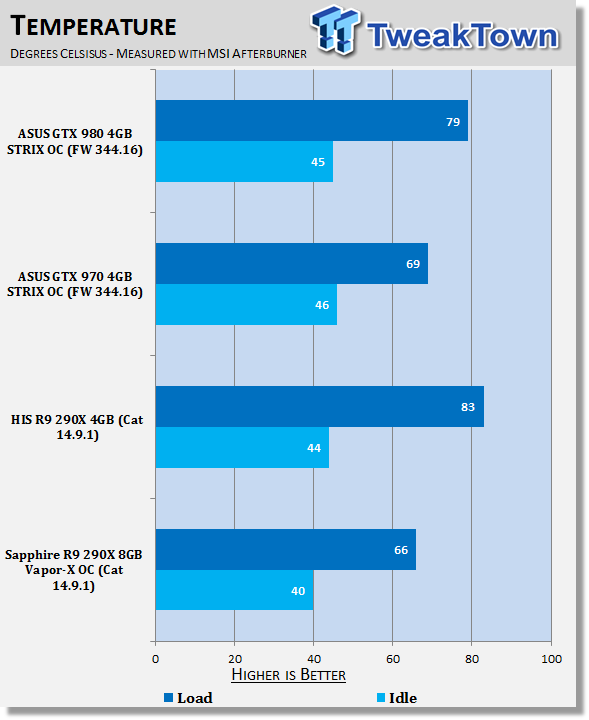
The Vapor-X cooler from Sapphire has always performed extremely well, and the results here are no different. Looking above, you can see the load and idle numbers are extremely impressive against the other cards here.
Sound Test

Pulling out the TES 1350A Sound Level Meter, we quickly find ourselves yelling into the top of it to see how loud we can be.
After five minutes of that, we get a bit more serious, and place the device two CM away from the fan on the card to find the maximum noise level of the card when idle (2D mode), and in load (3D mode).

Noise levels come in a little higher, but are at a very good level overall. This really is a fantastic cooler, and it's one area that Sapphire rarely disappoints in.
Power Consumption Testing

Using our PROVA Power Analyzer WM-01 -or "Power Thingy" as it has quickly become known as to our readers- we are now able to find out what kind of power is being used by our test system and the associated video cards installed. Keep in mind that it tests the complete system (minus LCD monitor, which is plugged directly into AC wall socket).
There are a few important notes to remember, though. While our maximum power is taken in 3DMark06 at the same exact point, we have seen the power being drawn as much as 10 percent more in particular tests. We test at the exact same stage every time, so tests should be very consistent and accurate.
The other thing to remember is that our test system is bare minimum -only a SSD is used, with a single CD ROM, and minimal cooling fans.
So, while the system might draw 400 watts in our test system, placing it into your own PC with a number of other items will result in a higher draw.

Power draw numbers on the new Maxwell based GTX 900 cards are extremely impressive, and you can see that compared to the AMD offerings, they sit a bit lower. Comparing the Sapphire with the reference designed HIS, you can see idle and load numbers are a little higher, but neither are troubling. For a setup like this, we'd recommend a quality 600 watt power supply.
Pricing, Availability, and Final Thoughts
It's tough to be disappointed with the performance of the 8GB version of the R9 290X offered by AMD and Sapphire. The simple fact is that after testing hundreds of video cards over a twelve year span, it was fairly safe to assume that doubling the memory was going to give little to no increase in performance over the reference designed card. Our assumption was not wrong.
What did give the biggest boost in performance was the increased clock speeds. Which unfortunately, aren't as high as we'd hope. We would've loved to have seen Sapphire be more aggressive with the clock speeds; for example, the 4GB version of this card comes with a core clock of 1080MHz, while the TOXIC offers 1150MHz.
Doubling the memory is going to set you back an extra $100 - $130, depending on the model you compare this 8GB version to. That's still around $100 - $150 cheaper than a GTX 980 4GB, which is what we'd hope considering it's not as fast as one. It's still about $100 more expensive than a GTX 970 4GB, and that continues to be the main competition for the model.
From what we've been told, AMD's high-end cards have barely moved in Q3, and partners are preparing for the worst when it comes to Q4. If this was six months ago, and these prices where in place, this would be an easy buy. However, NVIDIA really shook things up with the GTX 900 series, and with rumors of a Ti version of the 980, and a TITAN II, it seems that NVIDIA wants to continue to put the hurt on AMD.
However, it's not all bad news for AMD. The R9 300 based cards sound awesome, and feature some fantastic technology. These are not due till next year, though, and AMD is going to miss out on the holiday season in a big way. The Sapphire R9 290X 8GB Vapor-X OC is a great card; the 4GB version is also fantastic, and the TOXIC model is another great option. The problem is: these cards all revolve around a model that we've had for over a year now.
The R9 290X is a great card, but for the most part, it's just hard to recommend it, especially since once the R9 300 series comes out, AMD is undoubtedly going to shift their focus to making sure that each driver release brings improvements to those models. We can't see a whole lot of these 8GB models being made because partners would know exactly what we know: they're just not really going to sell.
Unfortunately for Sapphire, this is one of those times where they've done everything they could with what AMD has given them, with no real promise for return. The features and quality of the card are fantastic, and up to the typical Sapphire standard. The performance is strong as you'd expect, but doubling the RAM brings a price increase that is hard to justify when it comes down to raw performance. At 4K, where you'd think the card would really shine, we continued to see little change. The only time there was a consistent performance increase that is clearly due to the memory, and not the clock increase, is under GRID Autosport. If whatever was done here could also be done under other benchmarks, AMD and Sapphire would be onto a real winner.
For now, though, the 8GB version of the R9 290X is a last ditch effort by AMD to bring some attention to themselves, and get some sales over the holiday season. However, it is just not enough to make any real impact on the market. Those memory hungry people are going to buy it, but when it comes down to it all, your money can be better spent elsewhere.
PRICING: You can find the Sapphire R9 290X 8GB Vapor-X OC for sale below. The prices listed are valid at the time of writing, but can change at any time. Click the link to see the very latest pricing for the best deal.
United States: The Sapphire R9 290X 8GB Vapor-X OC retails for $499.99 at Amazon.
